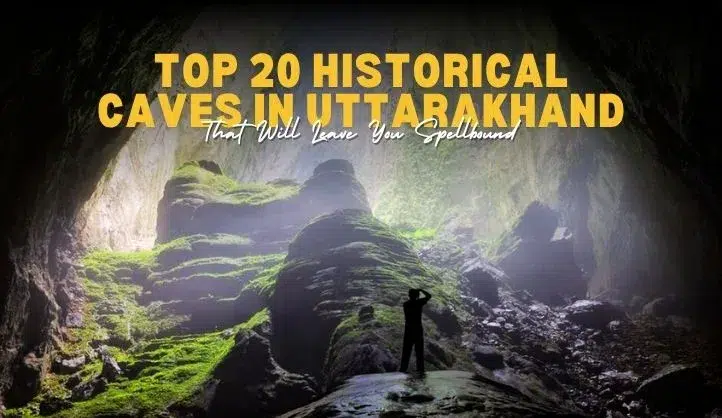Top 20 Historical Caves in Uttarakhand – Uttarakhand, often referred to as Devbhoomi (Land of the Gods), is a region where nature and spirituality walk hand in hand. With its mighty rivers, snow-capped peaks, and dense forests, the state is home to ancient temples, sacred treks—and mysterious caves filled with history, myths, and natural beauty.
Many caves here are tied to legendary figures like the Pandavas, Sage Vashistha, Ved Vyas, and even Mahavatar Babaji. Others are geological wonders formed over thousands of years, full of intriguing stalactites, underground rivers, and echoes of silence. These natural sanctuaries have served as meditation spots, spiritual hideouts, and secret getaways through the ages.
In this blog, you’ll discover 20 of the most historical and captivating caves in Uttarakhand—each offering a unique blend of mythology, trekking thrill, and spiritual experience. Whether you seek peace, adventure, or heritage, these caves will awaken the explorer in you.
Get ready for this underground journey across Garhwal and Kumaon!
1. Patal Bhuvaneshwar Cave – Pithoragarh
Patal Bhuvaneshwar is one of the most mystical caves in India. According to legend, this cave is the underground abode of 33 crore Hindu deities. Even Adi Shankaracharya visited it in the 8th century. Inside, you’ll find natural formations of gods, animals, and mythological figures formed by stalactites and stalagmites. The cave goes 90 feet deep and stretches over 160 meters. It’s dimly lit and narrow, but every twist reveals a divine figure—like Kal Bhairav, Shiva’s tongue, and Amarnath ice lingam.
📍 Location: 14 km from Gangolihat, Pithoragarh
🕒 Timings: 9 AM–5 PM | 💰 Entry Fee: ₹90
🏨 Travel Suggestion: Stay in Gangolihat homestays or book local guided cave tours.
2. Vashistha Cave – Near Rishikesh
Named after Sage Vashistha, this sacred cave is believed to be his meditation spot. The cave is located near the Ganga River and surrounded by a peaceful forest. Today, it is popular among yoga practitioners and seekers of silence. The environment is quiet, cool, and naturally soothing—ideal for inner reflection. Just outside is a small Shiva temple. There’s also an ashram nearby where spiritual retreats are held. The energy inside the cave is still and grounding.
📍 Location: 25 km from Rishikesh
🕒 Best Time: Year-round | 💰 Entry: Free
🧘 Travel Suggestion: Promote it alongside yoga retreats and wellness camps in Rishikesh.
3. Robber’s Cave (Guchhu Pani) – Dehradun
Robber’s Cave is a natural cave formation where a stream of water flows through the middle. It’s not spiritual, but rather known for its adventure appeal. During British times, it was used by robbers as a hideout—hence the name. Visitors can walk through the shallow stream with water flowing beneath their feet and walls towering on both sides. It’s cool inside even during hot summers. A small waterfall at the end makes it perfect for photos and picnics.
📍 Location: 8 km from Dehradun city
🕒 Timings: 7 AM–6 PM | 💰 Entry Fee: ₹35
☕ Travel Suggestion: Suggest nearby adventure tour operators or cafes.
4. Khatling Cave – Tehri Garhwal
This remote cave is found on the trekking route to Khatling Glacier. It is used by trekkers as a temporary shelter or camping point. The cave is naturally formed and offers views of surrounding snow-covered peaks. It is not a tourist spot for casual visitors but an experience for true adventurers. You must trek several kilometers from Ghuttu to reach it. This region remains pristine and quiet—ideal for solitude and raw Himalayan exploration.
📍 Location: Near Ghuttu, Tehri Garhwal
🥾 Access: Requires multi-day trek
🎒 Travel Suggestion: Trekking agencies can offer Khatling Glacier expeditions including this cave.
5. Vyas Cave – Mana Village
Vyas Cave, located in Mana—the last village of India—is believed to be the spot where Ved Vyas composed the Mahabharata while Lord Ganesha wrote it down. The cave has deep spiritual energy and overlooks the Saraswati River. Nearby attractions include Ganesh Gufa and Bheem Pul. The location is pristine, and the views of Himalayan peaks make it even more appealing. The cave is a small room-like structure with ancient carvings and mythological symbolism.
📍 Location: Mana Village, near Badrinath
🕒 Season: May to October | 💰 Entry: Free
🛕 Travel Suggestion: Combine with Badrinath yatra or Mana sightseeing tours.
6. Pandav Gufa – Gangotri
Pandav Gufa is believed to have been used by the Pandavas during their exile. It lies around 1.5 km from Gangotri Temple and is surrounded by deodar forests and mountain views. The trek to the cave is short but scenic. Inside, you’ll find a peaceful chamber where visitors meditate. The cave is linked with mythological tales of the Mahabharata and offers a sense of isolation and spiritual calm.
📍 Location: Gangotri, Uttarkashi
🥾 Trek: 1.5 km from Gangotri Temple | 💰 Entry: Free
🏞️ Travel Suggestion: Add to Gangotri and Gaumukh pilgrimage packages.
7. Budher Caves – Chakrata
Budher Caves are said to have been built by the Pandavas during the Mahabharata era. Located in a remote region near Chakrata, these limestone caves stretch underground for several kilometers. Although only a small portion is open to the public, it’s a hiker’s delight. Reaching the cave involves a moderate trek through green meadows and deodar forests. It is ideal for those looking for offbeat Himalayan experiences.
📍 Location: 30 km from Chakrata
🥾 Access: 2 km trek from Forest Rest House
🏕️ Travel Suggestion: Perfect for eco-lodges and hiking tours.
8. Gauri Udiyar Cave – Bageshwar
This lesser-known cave is rich in culture and carvings. The name “Udiyar” means cave, and Gauri refers to Goddess Parvati. The cave houses ancient stone idols believed to be carved by Vishwakarma, the divine architect. It’s peaceful and offbeat, making it a great stop for heritage and religious travelers. The forested path adds charm to the short journey.
📍 Location: 8 km from Bageshwar
🕒 Best Time: October–June
🏛️ Travel Suggestion: Include in heritage tours and Kumaon cultural circuits.
9. Mahavatar Babaji Cave – Dunagiri, Almora
One of the most sacred caves in Uttarakhand, Mahavatar Babaji’s cave is located near Dunagiri. This is where he appeared to Lahiri Mahasaya and initiated him into Kriya Yoga. The cave is now a pilgrimage site for Kriya Yoga followers. Reaching it involves a steep but short trek from Dwarahat. The location is peaceful and surrounded by dense pine forests.
📍 Location: Near Dwarahat, Almora
🥾 Trek: 700 m uphill | 🧘 Best For: Spiritual seekers
🏡 Travel Suggestion: Add to spiritual retreats or Babaji pilgrimage itineraries.
10. Timmersain Mahadev Cave – Munsiyari
This untouched cave near Munsiyari houses a naturally formed Shiva Linga. The trail is rugged, passing through scenic Himalayan landscapes. It’s relatively unknown, making it a quiet and sacred experience for pilgrims and trekkers alike. The cave is associated with Shiva worship and is revered by locals for its spiritual energy.
📍 Location: Near Munsiyari
🥾 Access: Guided trek required
🗻 Travel Suggestion: Offer with Munsiyari trekking & Panchachuli tours
11. Rudreshwar Cave – Rudraprayag
Rudreshwar Cave is a sacred and serene spot near Koteshwar Mahadev Temple in Rudraprayag. According to local legends, Lord Shiva meditated here before manifesting as Rudra. Inside the cave, there is a naturally formed Shivling, and the space is cool and quiet. Devotees often visit during Mahashivratri to offer prayers. The location also offers views of the confluence of the Alaknanda and Mandakini rivers.
📍 Location: Near Koteshwar, Rudraprayag
🕒 Best Time: Year-round | 💰 Entry: Free
🛕 Travel Suggestion: Include in Panch Prayag or Kedarnath pilgrimage tours.
12. Ganesh Gufa – Mana Village
Located very close to Vyas Gufa, this cave is believed to be where Lord Ganesha wrote down the Mahabharata as dictated by Ved Vyas. The cave features natural rock formations, and visitors can feel a deep sense of stillness and devotion. The site also offers panoramic views of the Saraswati River and snow-clad mountains. It’s one of the must-visit sites in the Mana-Badrinath region.
📍 Location: Mana Village
🕒 Best Time: May–October | 💰 Entry: Free
📚 Travel Suggestion: Package with Mana village sightseeing or Badrinath yatra.
13. Tapkeshwar Mahadev Cave – Dehradun
Tapkeshwar Mahadev is a unique cave temple dedicated to Lord Shiva. A natural spring drips water continuously over the Shivling, which gives the place its name—‘Tapkeshwar’ (dripping Lord). This cave is located inside a forested area and is very popular among locals and tourists. There are nearby ghats and meditation spots, making it an ideal spiritual stop in Dehradun.
📍 Location: Garhi Cantt, Dehradun
🕒 Timings: 6 AM–7 PM | 💰 Entry: Free
🧘 Travel Suggestion: Pair with Sahastradhara or local cultural tours.
14. Lakhudiyar Cave – Almora
Lakhudiyar means “one lakh caves,” and this site is famous for prehistoric rock paintings. Found near Barechhina in Almora, the cave walls feature red, black, and white drawings of animals, human figures, and abstract symbols made by ancient tribes. It’s an archaeological treasure and offers insight into the early human life in the Himalayas. This cave is a paradise for history buffs and anthropology lovers.
📍 Location: Barechhina, Almora
🕒 Access: Drive + short hike | 💰 Entry: Free
🖼️ Travel Suggestion: Include in heritage and educational tours.
15. Gupt Ganga Cave – Devprayag
This small yet spiritually powerful cave is located along the holy town of Devprayag—the meeting point of Alaknanda and Bhagirathi rivers. The cave contains a hidden stream believed to be the Ganga flowing underground. Pilgrims believe that bathing in the water here cleanses the soul. It’s a peaceful and quiet place, perfect for reflection and devotion.
📍 Location: Devprayag
🕒 Access: Walking distance from main town | 💰 Entry: Free
🕉️ Travel Suggestion: Add to Chardham circuit or confluence pilgrimages.
16. Shakti Cave – Uttarkashi
Shakti Cave is a hidden spiritual site connected to the worship of Goddess Durga. It is believed that the divine feminine power resides here. The cave is relatively unknown to tourists, but locals visit during special religious days, especially during Navratri. Set amidst forests and hills, it is a good spot for quiet spiritual practice and meditation.
📍 Location: Near Joshiyara, Uttarkashi
🕒 Season: March–June & Sept–Nov | 💰 Entry: Free
🌸 Travel Suggestion: Pair with Durga temple visits or Shakti Peeth tour.
17. Chaukhamba Cave – Kedarnath Region
Located near Vasuki Tal during the Kedarnath trek, this natural cave is often used by sadhus and trekkers for overnight shelter. Named after the Chaukhamba mountain massif, the cave offers stunning views of the surrounding Himalayan peaks. Though it doesn’t hold strong mythological significance, it’s a raw and real part of the Himalayan trekking experience.
📍 Location: Kedarnath trek route
🥾 Access: 7–8 km from Kedarnath
⛺ Travel Suggestion: Useful rest point for guided high-altitude treks.
18. Gufa Mahadev – Ranikhet
This forest-hidden Shiva cave is revered by locals and considered sacred. The interior features a stone Shivling, and the surrounding area is rich with pine and oak trees. Pilgrims come here to perform rituals and seek blessings. It’s not widely commercialized, offering a calm and authentic experience.
📍 Location: Near Majkhali, Ranikhet
🕒 Access: Drive + short walk | 💰 Entry: Free
🌲 Travel Suggestion: Combine with Ranikhet hill station and temple tours.
19. Jageshwar Dham Cave – Almora
Near the famous Jageshwar Temple complex is a small meditation cave used by ancient sages. It offers peace and seclusion, ideal for those wanting to meditate. The surrounding area is filled with towering deodar trees, and the silence here is profound. The cave itself is not big, but it holds spiritual value due to its proximity to one of the oldest Shiva temples in India.
📍 Location: Jageshwar, Almora
🕒 Access: Drive-in | 💰 Entry: Free
🛕 Travel Suggestion: Add to spiritual heritage packages in Kumaon.
20. Bhairav Gufa – Kalimath
Near Kalimath Temple, this cave is believed to be the place where Lord Bhairav meditated and later disappeared into the earth. The energy inside is intense, and only serious spiritual seekers visit it. The cave is dark and narrow, enhancing its mysterious and powerful aura. It is considered one of the Shakti Peeths in the region.
📍 Location: Near Kalimath, Rudraprayag
🕒 Access: Short hike | 💰 Entry: Free
🔥 Travel Suggestion: Include in tantric pilgrimage circuits or Rudraprayag tours.
Combine Caves with Wellness & Trekking
Looking to mix sacred with scenic? Here are 4 amazing combinations:
Vashistha Cave + Beatles Ashram + Neer Garh Waterfall
- Spiritual retreat + nature escape in Rishikesh
Budher Caves + Tiger Falls + Chakrata Forest Trek
- Offbeat Himalayan weekend for adventure lovers
Mahavatar Babaji Cave + Dwarahat Temples + Dunagiri Hill Retreat
- For Kriya Yoga and meditation journeys
Pandav Gufa + Gangotri Temple + Gaumukh Glacier Trek
- Spirituality and trekking in one unforgettable route
FAQs About Historical caves in Uttarakhand
1. What is the most famous historical cave in Uttarakhand?
Vashishta Gufa is one of the most famous and spiritually significant caves in Uttarakhand. It is believed that Sage Vashishta, the Guru of Lord Rama, meditated here on the banks of River Ganga near Rishikesh.
2. Are these caves natural or man-made?
Most of the caves in Uttarakhand are natural formations, though many have been shaped or maintained by humans over centuries. Some, like the Kalimath Cave, have religious structures nearby and are considered sacred pilgrimage sites.
3. Can tourists visit all these caves?
Many caves are accessible to tourists, especially ones like Tapkeshwar Mahadev Cave and Robber’s Cave (Guchhu Pani). However, some remote caves like Rudranath Cave or Patal Bhuvaneshwar may require trekking and permission from forest or tourism authorities.
4. Are guides available at these cave sites?
Yes, at most popular sites like Patal Bhuvaneshwar, Tapkeshwar Cave, and Robber’s Cave, local guides are available who can share the mythological and historical background of the caves.
5. What is the best time to explore caves in Uttarakhand?
The best time to visit these caves is between March and June or September and November when the weather is pleasant and suitable for trekking or sightseeing.
6. Are these caves safe for kids and elderly people?
Some caves like Robber’s Cave or Tapkeshwar Cave are quite tourist-friendly and safe for all age groups. But remote caves such as Mahavatar Babaji Cave or Pandav Cave may require physical fitness due to trekking routes.
7. Is there any accommodation available near these caves?
Yes, in places like Rishikesh, Dehradun, Gangolihat, and Joshimath, you can find guest houses, ashrams, and homestays close to the caves.
8. What should I carry while exploring caves in Uttarakhand?
You should carry:
-
Flashlight or headlamp
-
Water bottle
-
Comfortable walking shoes
-
A light jacket
-
Basic first-aid
-
ID proof (especially in forest areas)
9. Are there any religious rules to follow while visiting these caves?
Yes, many caves like Patal Bhuvaneshwar, Kalimath Cave, and Rudranath Cave are sacred. Remove shoes, maintain silence, avoid littering, and respect local traditions and priests while visiting.
10. Which cave is believed to connect to Kailash Mansarovar?
Patal Bhuvaneshwar Cave is believed to have a mythical underground passage to Kailash Mansarovar. Many legends link this cave to the celestial world of Hindu mythology.
Call to Action
Ready to explore the mystical underworld of Uttarakhand?
✨ Book a guided cave tour, join a Kriya Yoga retreat, or plan a custom cave trekking itinerary with our expert team.
Click below to speak to a travel advisor today.





